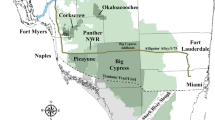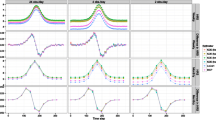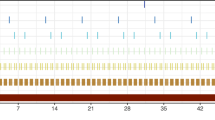Abstract
Traditional VHF radio-tracking is gradually being replaced by GPS tracking devices in spatial ecology studies, although both technologies continue to be used. Differences between tracking regimes (time and fix frequency) may lead to home range estimates that are not directly comparable. Our primary aim was to test the reliability of comparisons in home range estimates using different estimators (minimum convex polygon [MCP], fixed kernels [KDE] and dynamic Brownian Bridge Models [dBBMM]) and tracking regimes (see above) and to provide an empirical basis for linking VHS and GPS tracking data analysis, using the wild boar (Sus scrofa) as a study model. Data were obtained from 15 GPS-collared individuals from three areas in Mediterranean Spain. Using tracking data, we simulated different tracking regimes (approaches), from three relocations per week during the daytime to one location per hour in the case of more intensive continuous monitoring. Results suggested that MCP produces the greatest differences between approaches, while 95% kernel home range (Khr95) the lowest, both in size and utilization distribution overlap. From the 50% kernel core range (Kcr50), similar estimates were also obtained for the less intensive approaches (typical of VHF tracking regimes). Using the most intensive sampling scheme, dBBMM estimates did not differ significantly from those obtained with Khr95 for all approaches. The standardization of home range estimates is very important for wildlife management and conservation. The proposed methodology allows direct comparison among studies using different approaches for estimating home ranges.




Similar content being viewed by others
References
Baddeley A, Turner R (2005) Spatstat: an R package for analyzing spatial point patterns. J Stat Softw 12:1–42. https://doi.org/10.18637/jss.v012.i06
Barasona JA, Ramón López-Olvera J, Beltrán-Beck B et al (2013) Trap-effectiveness and response to tiletamine- zolazepam and medetomidine anaesthesia in Eurasian wild boar captured with cage and corral traps. BMC Vet Res 9:107. https://doi.org/10.1186/1746-6148-9-107
Barasona JA, Latham MC, Acevedo P et al (2014a) Spatiotemporal interactions between wild boar and cattle: implications for cross-species disease transmission. Vet Res 45:122. https://doi.org/10.1186/s13567-014-0122-7
Barasona JA, Mulero-Pázmány M, Acevedo P, Negro JJ, Torres MJ, Gortázar C, Vicente J (2014b) Unmanned aircraft systems for studying spatial abundance of ungulates: relevance to spatial epidemiology. PLoS One 9:e115608. https://doi.org/10.1371/journal.pone.0115608
Barber-Meyer SM, Mech LD (2014) Accuracy of estimating white-tailed deer diel May-June home ranges using only daytime locations. Wildl Biol Pract 10:62–68. https://doi.org/10.2461/wbp.2014.10.8
Baubet E, Brandt S, Vassant J et al (2004) Can wild boar be surveyed using GPS? Mem Natl Inst Polar Res:188–195
Benhamou S (2011) Dynamic approach to space and habitat use based on biased random bridges. PLoS One 6:e14592. https://doi.org/10.1371/journal.pone.0014592
Bhattacharyya A (1943) On a measure of divergence between two statistical populations defined by their probability distributions. Bull Calcutta Math Soc 35:99–109
Börger L, Franconi N, De Michele G et al (2006) Effects of sampling regime on the mean and variance of home range size estimates. J Anim Ecol 75:1393–1405. https://doi.org/10.1111/j.1365-2656.2006.01164.x
Brown CL, Hardy AR, Barber JR, Fristrup KM, Crooks KR, Angeloni LM (2012) The effect of human activities and their associated noise on ungulate behavior. PLoS One 7:e40505. https://doi.org/10.1371/journal.pone.0040505
Burnham KP, Anderson DR (2002) Model selection and multimodel inference: a practical information-theoretic approach, 2nd edn. Springer Verlag, New York
Burt WH (1943) Territoriality and home range concepts as applied to mammals. J Mammal 24:346. https://doi.org/10.2307/1374834
Cagnacci F, Boitani L, Powell RA, Boyce MS (2010) Animal ecology meets GPS-based radiotelemetry: a perfect storm of opportunities and challenges. Philos Trans R Soc B Biol Sci 365:2157–2162. https://doi.org/10.1098/rstb.2010.0107
Calenge C (2006) The package “adehabitat” for the R software: a tool for the analysis of space and habitat use by animals. Ecol Model 197:516–519. https://doi.org/10.1016/j.ecolmodel.2006.03.017
Calenge C, Dray S, Royer-Carenzi M (2009) The concept of animals’ trajectories from a data analysis perspective. Ecol Inform 4(1):34–41
Carrasco-Garcia R, Barasona JA, Gortazar C, Montoro V, Sanchez-Vizcaino JM, Vicente J (2016) Wildlife and livestock use of extensive farm resources in South Central Spain: implications for disease transmission. Eur J Wildl Res 62:65–78. https://doi.org/10.1007/s10344-015-0974-9
Casas-Díaz E, Closa-Sebastià F, Peris A et al (2013) Recorded dispersal of wild boar (Sus scrofa) in Northeast Spain: implications for disease-monitoring programs. Wildl Biol Pract 9:19–26. https://doi.org/10.2461/wbp.2013.ibeun.3
Cohen BS, Prebyl TJ, Collier BA, Chamberlain MJ (2018) Home range estimator method and GPS sampling schedule affect habitat selection inferences for wild turkeys. Wildl Soc Bull 42:150–159. https://doi.org/10.1002/wsb.845
Cutrera AP, Antinuchi CD, Mora MS, Vassallo AI (2006) Home-range and activity patterns of the South American subterranean rodent Ctenomys talarum. J Mammal 87:1183–1191. https://doi.org/10.1644/05-MAMM-A-386R1.1
David V (2017) Data treatment in environmental sciences, 1st. ISTE Press - Elsevier
Dinkins JB, Lawson KJ, Smith KT et al (2017) Quantifying overlap and fitness consequences of migration strategy with seasonal habitat use and a conservation policy. Ecosphere 8:e01991. https://doi.org/10.1002/ecs2.1991
Fieberg J, Börger L (2012) Could you please phrase “home range” as a question? J Mammal 93:890–902. https://doi.org/10.1644/11-MAMM-S-172.1
Fieberg J, Kochanny CO (2005) Quantifying home-range overlap: the importance of the utilization distribution. J Wildl Manag 69:1346–1359. https://doi.org/10.2193/0022-541X(2005)69
Fleming CH, Fagan WF, Mueller T, Olson KA, Leimgruber P, Calabrese JM (2015) Rigorous home range estimation with movement data: a new autocorrelated kernel density estimator. Ecology 96:1182–1188. https://doi.org/10.1890/14-2010.1
Fox J, Weisberg S (2011) An R companion to applied regression. In: Second edi. SAGE Publishing, Thousand Oaks, p 472
Girard I, Ouellet J-P, Courtois R et al (2002) Effects of sampling effort based on GPS telemetry on home-range size estimations. J Wildl Manag 66:1290–1300. https://doi.org/10.2307/3802962
Gula R, Theuerkauf J (2013) The need for standardization in wildlife science: home range estimators as an example. Eur J Wildl Res 59:713–718. https://doi.org/10.1007/s10344-013-0726-7
Hebblewhite M, Haydon DT (2010) Distinguishing technology from biology: a critical review of the use of GPS telemetry data in ecology. Philos Trans R Soc B Biol Sci 365:2303–2312. https://doi.org/10.1098/rstb.2010.0087
Hemson G, Johnson P, South A et al (2005) Are kernels the mustard? Data from global positioning system (GPS) collars suggests problems for kernel home-range analyses with least-squares cross-validation. J Anim Ecol 74:455–463. https://doi.org/10.1111/j.1365-2656.2005.00944.x
Horne JS, Garton EO (2006) Likelihood cross-validation versus least squares cross-validation for choosing the smoothing parameter in kernel home-range analysis. J Wildl Manag 70:641–648. https://doi.org/10.2193/0022-541x(2006)70[641:lcvlsc]2.0.co;2
Horne JS, Garton EO, Krone SM, Lewis JS (2007) Analyzing animal movements using Brownian bridges. Ecology 88:2354–2363. https://doi.org/10.1890/06-0957.1
Hothorn T, Bretz F, Westfall P (2008) Simultaneous inference in general parametric models. Biom J 50:346–363. https://doi.org/10.1002/bimj.200810425
Huck M, Davison J, Roper TJ (2008) Comparison of two sampling protocols and four home-range estimators using radio-tracking data from urban badgers Meles meles. Wildl Biol 14:467–477. https://doi.org/10.2981/0909-6396-14.4.467
Katajisto J, Moilanen A (2006) Kernel-based home range method for data with irregular sampling intervals. Ecol Model 194:405–413. https://doi.org/10.1016/j.ecolmodel.2005.11.001
Kenward RE, Clarke RT, Hodder KH, Walls SS (2001) Density and linkage estimators of home range: nearest-neighbor clustering defines multinuclear cores. Ecology 82:1905. https://doi.org/10.2307/2680056
Kenward RE, Arraut EM, Robertson PA, Walls SS, Casey NM, Aebischer NJ (2018) Resource-area-dependence analysis: inferring animal resource needs from homerange and mapping data. PLoS One 13:e0206354. https://doi.org/10.1371/journal.pone.0206354
Kernohan BJ, Gitzen RA, Millspaugh JJ (2001) Analysis of animal space use and movements. In: Millspaugh JJ, Marzluff JM (eds) Radio tracking and animal populations. Academic Press, San Diego, pp 125–166
Keuling O, Stier N, Roth M (2008a) Annual and seasonal space use of different age classes of female wild boar Sus scrofa L. Eur J Wildl Res 54:403–412. https://doi.org/10.1007/s10344-007-0157-4
Keuling O, Stier N, Roth M (2008b) How does hunting influence activity and spatial usage in wild boar Sus scrofa L.? Eur J Wildl Res 54:729–737. https://doi.org/10.1007/s10344-008-0204-9
Kie JG, Matthiopoulos J, Fieberg J et al (2010) The home-range concept: are traditional estimators still relevant with modern telemetry technology? Philos Trans R Soc Lond Ser B Biol Sci 365:2221–2231. https://doi.org/10.1098/rstb.2010.0093
Kochanny CO, Delgiudice GD, Fieberg J (2009) Comparing global positioning system and very high frequency telemetry home ranges of white-tailed deer. J Wildl Manag 73:779–787. https://doi.org/10.2193/2008-394
Kranstauber B, Kays R, Lapoint SD, Wikelski M, Safi K (2012) A dynamic Brownian bridge movement model to estimate utilization distributions for heterogeneous animal movement. J Anim Ecol 81:738–746. https://doi.org/10.1111/j.1365-2656.2012.01955.x
Kranstauber B, Smolla M, Scharf A (2018) Move: visualizing and analyzing animal track data
Laver PN, Kelly MJ (2008) A critical review of home range studies. J Wildl Manag 72:290–298. https://doi.org/10.2193/2005-589
Massei G, Genov PV, Staines BW, Gorman ML (1997) Factors influencing home range and activity of wild boar (Sus scrofa) in a Mediterranean coastal area. J Zool (Lond) 242:411–423
Merli E, Grignolio S, Marcon A, Apollonio M (2017) Wild boar under fire: the effect of spatial behaviour, habitat use and social class on hunting mortality. J Zool 303:155–164. https://doi.org/10.1111/jzo.12471
Millspaugh JJ, Marzluff JM (2001) Radio tracking and animal populations, 1st edition. Academic Press, San Diego
Mitchell LJ, White PCL, Arnold KE (2019) The trade-off between fix rate and tracking duration on estimates of home range size and habitat selection for small vertebrates. PLoS One 14:e0219357. https://doi.org/10.1371/journal.pone.0219357
Pellerin M, Saïd S, Gaillard J-M (2008) Roe deer Capreolus capreolus home-range sizes estimated from VHF and GPS data. Wildl Biol 14:101–110. https://doi.org/10.2981/0909-6396(2008)14
Penteriani V, Kuparinen A, del Mar DM et al (2013) Responses of a top and a meso predator and their prey to moon phases. Oecologia 173:753–766. https://doi.org/10.1007/s00442-013-2651-6
Pinheiro J, Bates D, DebRoy S, Sarkar D (2017) nlme: linear and nonlinear mixed effects models
Pintó J, Panareda JM (1995) Memòria del mapa de la vegetació de Sant Llorenç del Munt. Aster, Terrassa
Ponchon A, Grémillet D, Doligez B et al (2013) Tracking prospecting movements involved in breeding habitat selection: insights, pitfalls and perspectives. Methods Ecol Evol 4:143–150. https://doi.org/10.1111/j.2041-210x.2012.00259.x
R Core Team (2017) R: a language and environment for statistical computing
Rühmann J, Soler M, Pérez-Contreras T, Ibáñez-Álamo JD (2019) Territoriality and variation in home range size through the entire annual range of migratory great spotted cuckoos (Clamator glandarius). Sci Rep 9. https://doi.org/10.1038/s41598-019-41943-2
Russo L, Massei G, Genov PV (1997) Daily home range and activity of wild boar in a Mediterranean area free from hunting. Ethol Ecol Evol 9:287–294. https://doi.org/10.1080/08927014.1997.9522888
Saïd S, Tolon V, Brandt S, Baubet E (2012) Sex effect on habitat selection in response to hunting disturbance: the study of wild boar. Eur J Wildl Res 58:107–115. https://doi.org/10.1007/s10344-011-0548-4
Schuler KL, Schroeder GM, Jenks JA, Kie JG (2014) Ad hoc smoothing parameter performance in kernel estimates of GPS-derived home ranges. Wildl Biol 20:259–266. https://doi.org/10.2981/wlb.12117
Scillitani L, Monaco A, Toso S (2010) Do intensive drive hunts affect wild boar (Sus scrofa) spatial behaviour in Italy? Some evidences and management implications. Eur J Wildl Res 56:307–318. https://doi.org/10.1007/s10344-009-0314-z
Spencer WD (2012) Home ranges and the value of spatial information. J Mammal 93:929–947. https://doi.org/10.1644/12-MAMM-S-061.1
Thomas B, Holland JD, Minot EO (2011) Wildlife tracking technology options and cost considerations. Wildl Res 38:653–663. https://doi.org/10.1071/WR10211
Tolon V, Dray S, Loison A et al (2009) Responding to spatial and temporal variations in predation risk: space use of a game species in a changing landscape of fear. Can J Zool 87:1129–1137. https://doi.org/10.1139/Z09-101
Vieira WF, Kerry C, Hockings KJ (2019) A comparison of methods to determine chimpanzee home-range size in a forest–farm mosaic at Madina in Cantanhez National Park, Guinea-Bissau. Primates 60:355–365. https://doi.org/10.1007/s10329-019-00724-1
Walter WD, Fischer JW, Baruch-Mordo S, VerCauteren KC (2011) What is the proper method to delineate home range of an animal using today’s advanced GPS telemetry systems: the initial step. In: Krejcar O (ed) modern telemetry. InTech, pp 249–268
Walter WD, Onorato DP, Fischer JW (2015) Is there a single best estimator? Selection of home range estimators using area-under-the-curve. Mov Ecol 3:10. https://doi.org/10.1186/s40462-015-0039-4
Warton DI, Hui FKC (2011) The arcsine is asinine: the analysis of proportions in ecology. Ecology 92:3–10. https://doi.org/10.1890/10-0340.1
Worton BJ (1989) Kernel methods for estimating the utilization distribution in homerange studies. Ecology 70:164–168. https://doi.org/10.2307/1938423
Acknowledgements
We would like to thank Àngel Miño (Director) and the Sant Llorenç Natural Park rangers for their support. We are also indebted to Ana Villena and Sergio Peris for their critical reading of the earlier versions of the manuscript and to Rafel Bosch for the successful comments. The editor, Antonio Uzal and Robert Kenward provided relevant suggestions to improve this work.
Author information
Authors and Affiliations
Corresponding author
Ethics declarations
Conflict of interest
The authors declare that they have no conflict of interest.
Additional information
Publisher’s note
Springer Nature remains neutral with regard to jurisdictional claims in published maps and institutional affiliations.
Electronic supplementary material
ESM 1
(DOCX 28 kb)
Rights and permissions
About this article
Cite this article
Peris, A., Closa, F., Marco, I. et al. Towards the comparison of home range estimators obtained from contrasting tracking regimes: the wild boar as a case study. Eur J Wildl Res 66, 32 (2020). https://doi.org/10.1007/s10344-020-1370-7
Received:
Revised:
Accepted:
Published:
DOI: https://doi.org/10.1007/s10344-020-1370-7




